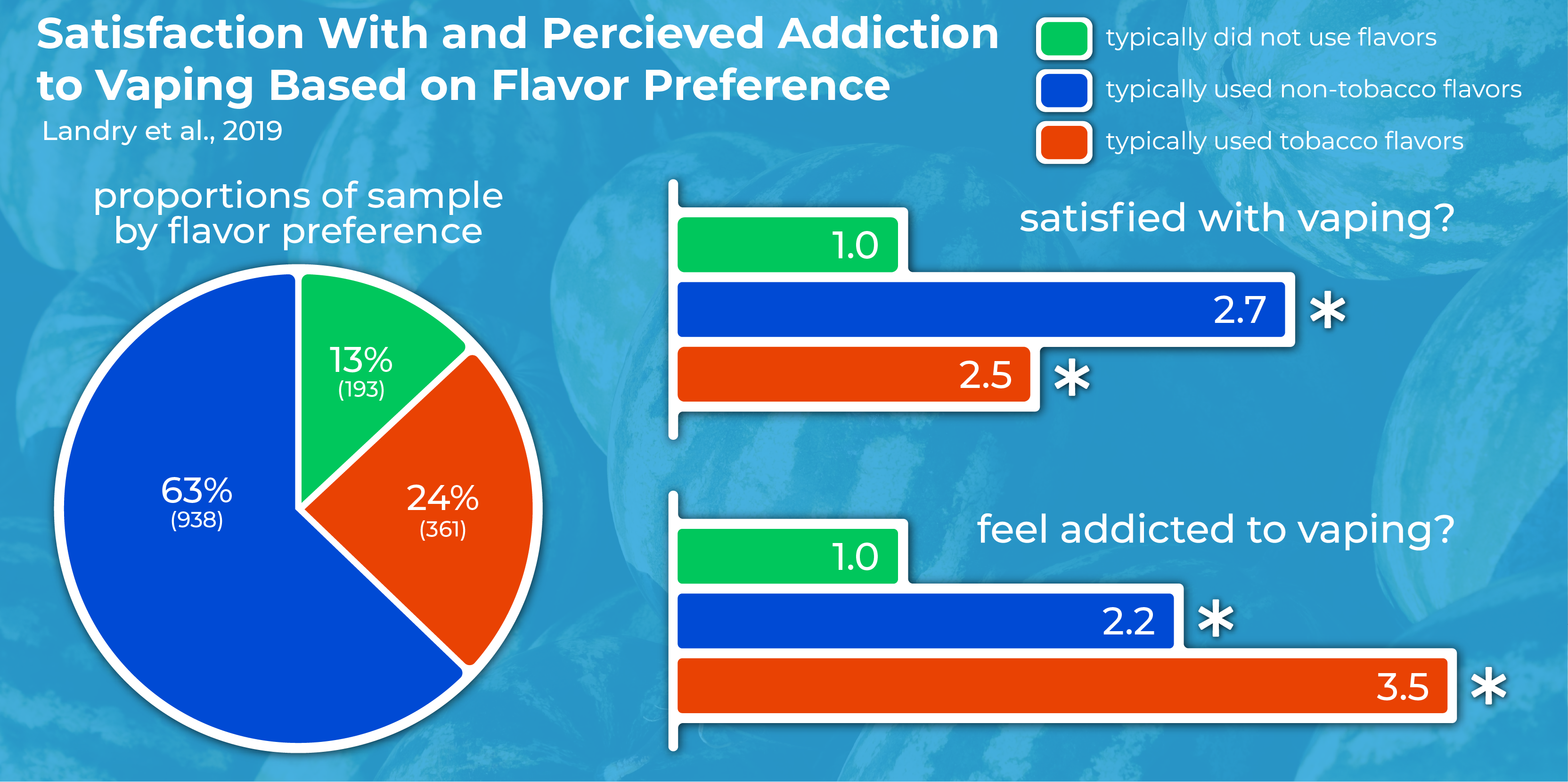For many e-cigarette users, flavors are essential to the experience of vaping. Most users prefer flavored e-liquids as opposed to non-flavored, and there are thousands of unique flavors to try, ranging from sweet flavors like fruit and candy to savory flavors like mint, spice, and tobacco. Given their immense popularity within the vaping community, flavors must be considered when seeking to understand vaping initiation, satisfaction, and addiction. This week, ASHES reviews a study by Robyn Landry and colleagues that explored how e-cigarette flavors relate to these topics in adult users.
What was the research question?
How do flavors contribute to vaping initiation, satisfaction, and addiction?
What did the researchers do?
The researchers gathered data from an online survey of 1,492 U.S. adults who regularly used e-cigarettes.1 The survey assessed participants’ age, demographics, reasons for taking up vaping, e-liquid flavor preferences, satisfaction with vaping, and whether they believed they were addicted to e-cigarettes. They grouped flavors into the following categories: tobacco flavor, non-tobacco flavors (including mint, menthol, and other flavors), and non-flavored. Using logistic regression, they examined the role of flavored e-cigarette liquid in vaping initiation, satisfaction, and addiction.2
What did they find?
Of all participants, 30% reported that flavor was a main reason for starting to vape. Flavor was the third most popular reason for starting to vape, after having an alternative to cigarettes (44%) and seeing vaping as less harmful than smoking (31%). When asked about flavor selection, 24% reported usually purchasing tobacco flavors, 63% usually purchasing flavors other than tobacco flavors, and 13% typically purchasing non-flavored e-liquids. The most popular flavor was fruit, used by 42% of participants. Participants aged 45 and older were most likely to buy tobacco flavors, while participants aged 18 to 24 were most likely to buy fruit and candy flavors. Participants who purchased any flavored e-liquids were significantly more likely to report high satisfaction with vaping and more likely to report feeling addicted to vaping than those who did not buy flavors (see figure).

Figure. Left: The sample of e-cigarette users broken down by flavor preference. Right: Odds ratios of feeling satisfied with vaping and feeling addicted to vaping by flavor preference, with “not using flavors” as the reference category. For example, users who typically used tobacco flavors have 3.5 times greater odds of feeling addicted to vaping on average than users who did not typically use flavored e-liquids. Asterisks denote significantly higher odds ratios. Click image to enlarge.
Why do these findings matter?
Flavored e-liquids appear to be strongly associated with vaping initiation, satisfaction, and addiction in the present sample of U.S. adults. This evidence complements previous research documenting the influence of flavors on e-cigarette use in young people. It is still unclear why flavors are so important, but some potential explanations are that some flavors taste better and/or may seem less harmful when associated with fruit. Studies like these can potentially inform plans to regulate or restrict certain e-liquid flavors; we’ve already begun to see the banning of flavorings in the U.S.
Every study has limitations. What are the limitations in this study?
The researchers purposefully oversampled people from minority racial and ethnic backgrounds as vulnerable populations of interest, so results should not be viewed as representative of the U.S. population as a whole. The survey questions that assessed whether participants thought they were addicted to vaping were not clinically validated, but rather developed from focus group research.
For more information:
SmokeFree offers tools and tips quitting and maintaining abstinence from smoking tobacco. The Center for Disease Control and Prevention offers information, tips, and tools about e-cigarettes and how to quit. For more information about addiction, visit our Addiction Resources page.
— Jamie Juviler
What do you think? Please use the comment link below to provide feedback on this article.
________________
1. This was defined as using e-cigarettes within the past week, for at least six months, and at least twenty times in total.
2. They also controlled for age, sex, race, ethnicity, education level, employment status, income, and whether participants smoked cigarettes.




